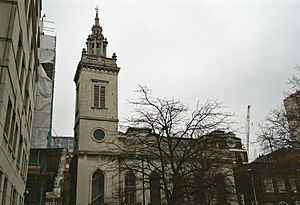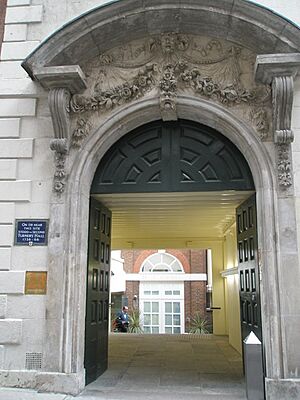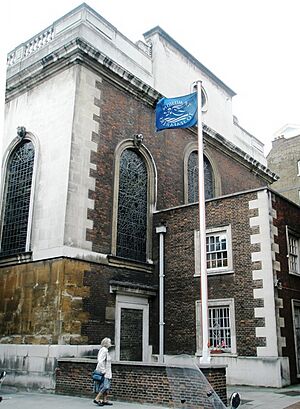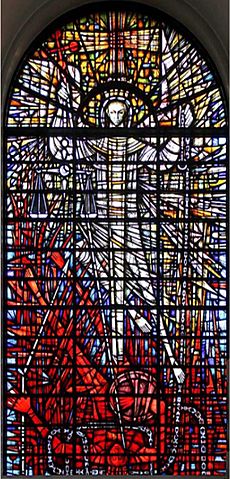St Michael Paternoster Royal facts for kids
Quick facts for kids St Michael Paternoster Royal |
|
|---|---|

Photo of St Michael Paternoster Royal
|
|
| Location | London |
| Country | England |
| Denomination | Church of England |
| Previous denomination | Roman Catholicism |
| Architecture | |
| Heritage designation | Grade I listed building |
| Architect(s) | Christopher Wren |
| Style | Baroque |
| Years built | 1694 |
| Administration | |
| Diocese | London |
St Michael Paternoster Royal is a historic church located in the City of London. The very first church building here was recorded way back in the 13th century. Sadly, it was completely destroyed in the terrible Great Fire of London in 1666.
After the fire, the church was rebuilt by the famous architect Sir Christopher Wren. However, St Michael's faced more challenges when it was badly damaged during the London Blitz in the Second World War. Luckily, it was carefully restored between 1966 and 1968, bringing it back to its former glory.
A very famous person, Richard "Dick" Whittington, who was a legendary Lord Mayor of London, was buried here in 1423. Even though his tomb is now lost, his connection to the church remains a big part of its story.
Contents
History of St Michael Paternoster Royal
Before the Great Fire of London, there were seven churches in London named after the Archangel Michael. Most of them, including St Michael Paternoster Royal, were rebuilt after the fire. The earliest mention of this church, as St Michael of Paternosterchierch, dates back to 1219.
Why the Name "Paternoster Royal"?
The "Paternoster" part of the name comes from its location on Paternoster Lane, which is now called College Hill. This lane was named after people who sold paternosters, which are like rosaries used for prayer.
The "Royal" part of the name appeared later, in the 14th century. It refers to a nearby street, now gone, called Le Ryole. This name was a changed version of La Reole, a town in Bordeaux, France. The street was called this because many wine merchants from that area lived and worked there.
Richard Whittington's Connection
In the early 15th century, a very important local resident was Richard Whittington. He was elected Lord Mayor of London four times! In 1409, he generously paid for the rebuilding and expansion of St Michael Paternoster Royal. He bought an empty piece of land nearby to make the church bigger.
Later, Whittington founded the College of St Spirit and St Mary inside the church. This made St Michael's a collegiate church. This means it was managed by a group of five priests instead of just one rector. It became widely known as Whittington's College or Whittington College.
Next to the church, Whittington also started an almshouse, which was a place for poor people to live. The college was later closed down by King Edward VI in 1548. However, it was reopened a few years later by Queen Mary. The names College Street and College Hill still remind us of this college today. The almshouse also moved over time, eventually settling in East Grinstead in 1966.
Whittington's Burial and Other Notable People
Sir Richard Whittington was buried in St Michael's in 1423, close to his wife, Alice. There's a curious story that his body was dug up by a rector named Thomas Mountain during King Edward VI's reign. Mountain thought Whittington was buried with treasure! He wasn't, but Mountain did take his leaden burial shroud. The grave was dug up again during Queen Mary I's reign, and his body was re-covered in lead. An attempt to find his grave in 1949 only found a mummified cat, but no Lord Mayor!
Other important people buried in the church before the Great Fire included William Oldhall, who was Speaker of the House of Commons, and Peter Blundell, who founded Blundell's School.
Rebuilding After the Great Fire
After the church was destroyed in the Great Fire, its parish was joined with that of St Martin Vintry, another church that was destroyed and not rebuilt. Construction of the new St Michael's church began in 1685. It was one of the last of the 51 churches to be rebuilt after the fire. Building paused in 1688 due to money problems during the Glorious Revolution.
Work started again the next year, overseen by Wren's master builder, Edward Strong the Elder. The church was finished in 1694. Its tall steeple was added between 1713 and 1717. The total cost to rebuild the church was £8,937.
A monument to another Lord Mayor, Sir Samuel Pennant, sculpted by Michael Rysbrack, was added in 1750. Pennant sadly died from a disease called jail fever that he caught from prisoners.
World War II Damage and Restoration
St Michael's had several updates in the 19th century. However, on July 23, 1944, the church was hit by a V1 flying bomb during World War II. Only its walls and tower were left standing.
Church services continued in the damaged building until 1955. The local church leaders wanted to demolish the walls and keep only the tower. But the City of London Corporation disagreed and successfully argued to restore the whole church. It was restored by Elidir Davies between 1966 and 1968. It was the very last church in the City to be restored after the war.
The church was officially reopened by the Duke of Edinburgh on December 19, 1968. It became the main office for the Mission to Seamen, now called the Mission to Seafarers. This is an Anglican group that helps chaplains in ports all over the world.
St Michael Paternoster Royal is a chapel under the Bishop of London. Since 2018, the Bishop of London's office has been located there. In 2024, the church was put up for sale. It was described as a "former Wren church" and having "three floors of open plan offices."
Architecture of St Michael Paternoster Royal
St Michael's church has a rectangular shape. Only the front facing College Hill is slightly uneven. Before World War II, buildings crowded the south side of the church. After the bomb damage, these buildings were cleared away, and the Whittington Garden was created there. This means the church's main front is now on the south side, along Upper Thames Street.
The south front is covered with Portland stone, a type of limestone. It has six arched windows, each with a small angel face carved above it. The north and east sides, which are less visible, are made of brick. The roof has a decorative railing around it.
You enter the church through the tower, which is in the southwest corner. The tower has an arched window at the bottom, then a round window, and then a square window for the bells. At the very top, there's a decorative railing with square urns on the corners.
The stone spire was designed by Nicholas Hawksmoor. It looks similar to the spires of other famous churches like St Stephen Walbrook and St James Garlickhythe. It's an open octagon shape, made of eight Ionic columns, each with its own top part and an urn. Above this is another, smaller octagon with eight more columns and urns. On top of the second octagon is a tiny dome with a flag-like weather vane. The tower and spire together are 128 feet tall.
St Michael Paternoster Royal was given a Grade I listed building status on January 4, 1950. This means it's a very important historic building that needs to be protected.
Inside St Michael Paternoster Royal
The inside of St Michael's is divided into different areas because the church has two main purposes. The western part of the building, which is roughly where the original 13th-century church stood, now holds a hall, an entrance area, and the offices for the Mission to Seafarers.
The chapel is in the larger, eastern part of the church. The east wall has three beautiful stained glass windows designed by John Hayward in 1968. The main window shows St Michael stepping on a red-winged Satan. The windows on either side show the Virgin Mary with baby Jesus, and Adam and Eve with St Gabriel and the serpent. On the south wall, another stained glass window shows Dick Whittington with his famous cat.
The reredos, which is a decorative screen behind the altar, is original to the church. It has four Corinthian columns and two flaming urns. In front of it are two Baroque statues from the 17th century, showing Moses and Aaron. These statues were moved here from another church, All-Hallows-the-Great, when it was torn down in 1894. The statues' hands were damaged in the war and have been replaced. Moses used to hold a pointer towards the Decalogue (the Ten Commandments), and Aaron held a censer (a container for burning incense). Now, Aaron raises his hands in a blessing.
Also from All-Hallows-the-Great is a fancy chandelier, marked "Birmingham 1644." The organ case is a copy of the original 1749 organ case from All-Hallows-the-Great, which was destroyed in the war. It holds a Noel Mander organ. In front of the organ gallery, there's a rare old carving of King William III's coat of arms.
The pulpit, communion rails, and lectern are from the 17th century. The rest of the wooden features inside the church were added in the 1960s during the restoration.
Burials
- Richard Whittington (c. 1354–1423), though his tomb is now lost
- Samuel Pennant
See also
- List of churches and cathedrals of London
- List of Christopher Wren churches in London
- John Albert Douglas, vicar of St Michael Paternoster Royal from 1933 to 1952




